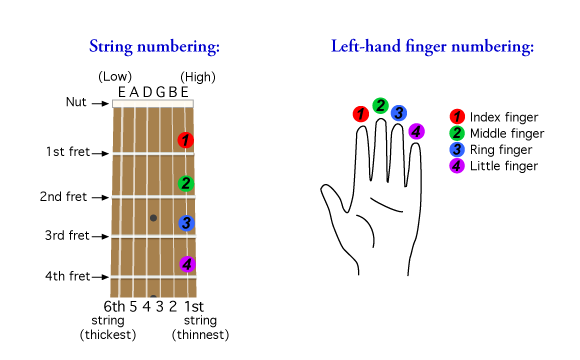Welcome this set of free guitar lesson to help you learn how to play guitar. Most of the content is taken from the award-winning eMedia Guitar Method guitar lesson software, minus the interactive elements which are not possible using current website technology.
As you go through the lessons, be sure to use proper hand and finger technique and don’t try to rush things. Play guitar chords and notes cleanly. You will want to be sure that you don’t develop bad habits that can hinder your progress later on.
Types of Guitars and Parts of the Guitar
Here is an overview of the different types of guitars and their parts. Note that some music styles require certain guitar techniques, and some guitars support those technique better than others. For example, the string bends done in blues and rock would be almost impossible on a classical guitar. This instrument is not designed for it, as string bends are not found in classical guitar repertoire. However, string bending is easy on an electric guitar, as they are built to support this technique.
Acoustic Guitars
Acoustic guitars are designed to make sound without amplification. Some might include a pickup, but they are still designed as acoustic instruments. Acoustic guitars are like hollow boxes made of thin wood, with a sound hole in the front underneath the strings. This allows vibration of the guitar strings to radiate sound waves into the guitar body, which then resonates. The front of an acoustic guitar (called a top) is usually made of softer woods like spruce that let the wood vibrate. The back and sides are usually hardwoods (mahogany, rosewood, etc.) to reflect sound back towards the sound hole.
Classical and Nylon-String Guitar
 The classical acoustic guitar is commonly used for playing classical music — usually with the fingers, though a pick is also sometimes used. Unlike the electric and steel-string guitars, which have metal strings, the classical guitar has nylon strings, which can be easier on the fingers. The neck of the classical guitar is slightly wider and, likewise, so is the spacing between the strings. You also find nylon-stringed guitars used in flamenco and folk music. You should never try to put steel strings on these instruments, as they have no reinforcement in their necks to deal with the extra tension. Listen to how the nylon string acoustic sounds below.
The classical acoustic guitar is commonly used for playing classical music — usually with the fingers, though a pick is also sometimes used. Unlike the electric and steel-string guitars, which have metal strings, the classical guitar has nylon strings, which can be easier on the fingers. The neck of the classical guitar is slightly wider and, likewise, so is the spacing between the strings. You also find nylon-stringed guitars used in flamenco and folk music. You should never try to put steel strings on these instruments, as they have no reinforcement in their necks to deal with the extra tension. Listen to how the nylon string acoustic sounds below.
Steel String Acoustic Guitar
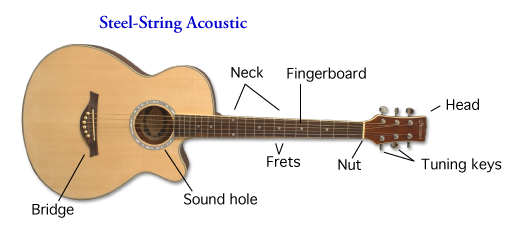 The steel-string acoustic is the most common acoustic guitar, and is perhaps the most versatile. As the name implies, it uses steel strings and is common in folk, country, blues, jazz, pop, and rock music. It can also sound great when playing classical pieces, but will be much brighter than a classical guitar. Steel-string acoustics are commonly strummed and played with a pick, but can also be played with the fingers using various fingerpicking techniques. Play below to hear how a steel-string acoustic guitar sounds.
The steel-string acoustic is the most common acoustic guitar, and is perhaps the most versatile. As the name implies, it uses steel strings and is common in folk, country, blues, jazz, pop, and rock music. It can also sound great when playing classical pieces, but will be much brighter than a classical guitar. Steel-string acoustics are commonly strummed and played with a pick, but can also be played with the fingers using various fingerpicking techniques. Play below to hear how a steel-string acoustic guitar sounds.
Electric Guitars
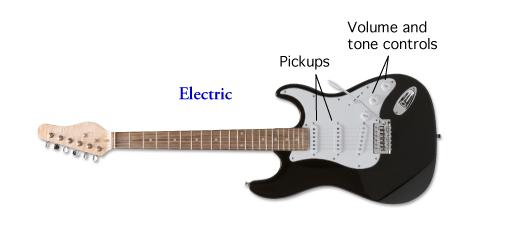 The electric guitar is hooked-up to an electronic amplifier and can be adjusted to create different types of electric guitar tones. Electric guitars are used primarily in pop, rock, country, blues, R&B and jazz. While usually played with a pick, it can also be played with fingers. The strings are usually thinner than the steel-string acoustic and the necks a bit easier to play. As a result, electric guitars can be a great fit for beginner guitarists who prefer the previously mentioned music styles. Hear the electric guitar licks below for a taste of how the electric guitar sounds.
The electric guitar is hooked-up to an electronic amplifier and can be adjusted to create different types of electric guitar tones. Electric guitars are used primarily in pop, rock, country, blues, R&B and jazz. While usually played with a pick, it can also be played with fingers. The strings are usually thinner than the steel-string acoustic and the necks a bit easier to play. As a result, electric guitars can be a great fit for beginner guitarists who prefer the previously mentioned music styles. Hear the electric guitar licks below for a taste of how the electric guitar sounds.
Tuning the Guitar
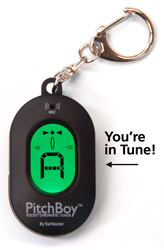 Tuning your guitar before you start playing is important, so you can easily hear when you are playing melodies and chords correctly. Learn how to tune a guitar using our online reference tuner. Or use our instructions for how to tune your guitar with a digital guitar tuner, if you have one of those.
Tuning your guitar before you start playing is important, so you can easily hear when you are playing melodies and chords correctly. Learn how to tune a guitar using our online reference tuner. Or use our instructions for how to tune your guitar with a digital guitar tuner, if you have one of those.
Digital guitar tuners, such as the PitchBoy mini tuner (pictured to the left), or the eMedia Guitar Toolkit make tuning a guitar easier, as you can tune visually with less dependance on your own ear’s ability to hear pitch differences.
Holding the Guitar
It is important to hold the guitar properly while playing it. This can affect your arm and hand position which is crucial to get right when learning how to play the guitar. Hold the neck with your left hand and pluck or strum the strings with your right hand. Keep the guitar face nearly vertical with the top inclined slightly toward the body. If sitting, try to sit straight — avoid bending over the guitar. Settle into a comfortable position and stay relaxed. The type of guitar you have affects how you sit or stand with the guitar. Here are some examples of good ways to hold different types of guitars.
Sitting Position
(right leg crossed over left)
Classical Position
(Left foot on raised platform)
Standing Position
(With guitar strap)
Right Hand Guitar Technique
The right hand is used to make the guitar string vibrate by touching the string with your fingers, thumb and/or guitar pick. The right hand should rest comfortably on the guitar, with the hand basically parallel to the front of the instrument. The main right-hand guitar techniques are:
How to Strum a Guitar
Strumming is used for playing chords on the guitar. You strum with either the thumb, index finger or all the fingers across the strings in an up and down motion. See video for a demonstration. With any of the strumming styles, the right arm rests on top of the guitar and the usual place to strum is just behind (toward the bridge) or over the sound hole. For an electric guitar, which doesn’t have a sound hole, the strumming is done over the pickups. This video shows you how to strum a guitar.
How to Hold a Guitar Pick
To learn how to hold a guitar pick, try making a loose fist and put the pick between your index finger and thumb. Don’t let too much of the pick be exposed as you need to control firmly as you strum and play individual notes. Keeping a minimal amount of pick exposed also keeps it from being caught in the guitar strings and coming out of your hand. When using a pick, alternate between down and up strokes, giving each note a separate stroke. Thus the first note would get a down stroke, the second an up stroke, the third down, the fourth up and so on. Here is a video to show you how to hold a pick.
Fingerpicking
This is the technique widely used by classical and folks guitarists. Here your hand rests above the guitar strings with the thumb roughly parallel to the strings and the rest of your fingers curved and plucking the strings perpendicularly. Note that some rock guitarists will use fingerpicking too. When using fingers (playing fingerstyle), pluck alternately with the index (i) and the middle (m) fingers. Thus use i for the first note, m for the second, i for the third, m for the fourth and so on.
Left Hand Guitar Technique
Here are some things to observe when developing proper left hand technique for guitar. Those are:
Play With Thumb Parallel to the Neck and Arched Fingers
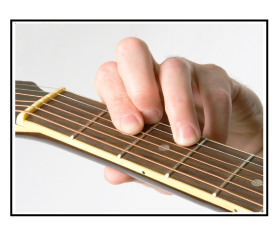 Your thumb should rest in the middle of the back of the neck, opposite your 2nd finger and vertical (perpendicular to the neck, not angled or parallel). Try holding your guitar neck with your left hand and then pull your hand down keeping your fingers slightly curved.
Your thumb should rest in the middle of the back of the neck, opposite your 2nd finger and vertical (perpendicular to the neck, not angled or parallel). Try holding your guitar neck with your left hand and then pull your hand down keeping your fingers slightly curved.
Keep space between the curve of your hand that is making the chord and the guitar neck. If you were to look at your hand from the end of your guitar (near the tuning machines), it should be in a “C” shape, with arched fingers.
Play On Your Finger Tips
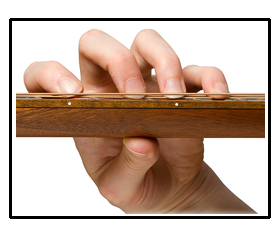 Make sure you play with the tips of your fingers, so that notes can ring out and not be accidentally muted. Do not let your finger flatten out when playing single strings.
Make sure you play with the tips of your fingers, so that notes can ring out and not be accidentally muted. Do not let your finger flatten out when playing single strings.
There is generally a one finger per fret,
rule, that says all notes played on a particular fret should be played by the same finger across all strings on that fret. For example, if the 1st finger is on the 3rd fret, it plays all notes on the 3rd fret across all strings, the 2nd finger plays notes across the 4th fret, the 3rd plays the notes across the 5th fret and so on. Then as you move your hand up and down the neck you always have maximum reach with minimal movement. Very important when playing melodies and riffs at higher tempos.
Play Slightly Behind the Fret and Don’t Press Too Hard
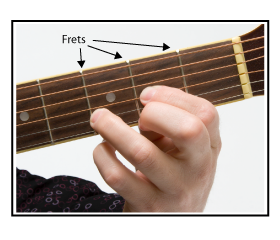 Your fingertips should press down just behind the frets (slightly towards the tuning machine end of the neck), and as close to the frets as possible without having your finger on the top of the actual fret. This will make it much easier to hold down the string to get a good tone. You should not need to press down very hard to make a note sound. If the note sounds muffled, your finger is probably on the fret and you need to move it back a bit.
Your fingertips should press down just behind the frets (slightly towards the tuning machine end of the neck), and as close to the frets as possible without having your finger on the top of the actual fret. This will make it much easier to hold down the string to get a good tone. You should not need to press down very hard to make a note sound. If the note sounds muffled, your finger is probably on the fret and you need to move it back a bit.
If your left-hand fingernails are too long, they may need to be trimmed.
Paying extra attention to technique as you learn how to play guitar pays off greatly as you start to improve. Getting the basics right during your initial beginner guitar lessons pays off a lot in the long run.
String and Finger Numbering
As seen in the graphic below, there is a guitar finger numbering system in place that indicates which finger to play relative to the frets. See the guitar fingering chart below for more information on guitar fingering notation.
Note: The dots on the side and face of the guitar neck are placed before the 3rd, 5th, 7th, 9th, 12th, 15th, 17th and 19th frets. The 12th fret has two dots. These dots help you find your way on the neck.
First Guitar Chords
The guitar chords below are called simple chords. They are perfect for beginner guitar lessons, as most of them only require a single finger and three strings to play. They are the most basic, easy guitar chords for beginners and work well for children with small hands, or others who might have problems playing full chords. Try playing them and remember to play all the notes in the chords.

Here are some videos to help you learn some of these beginning guitar chords and beginner guitar songs that use them.
How to Play a Simple G Chord
Beginner Guitar Song #1: Play Brother John/Frere Jacques
Now use your simple G chord to play this classic folk song. Each slash (/) indicates a downward strum on the beat. If possible, play to a metronome click so that you can to stay on the beat.
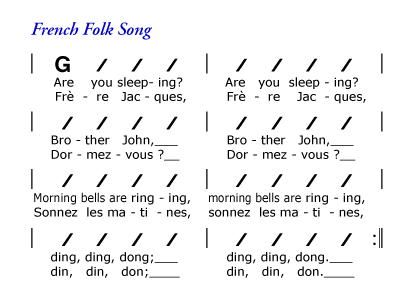
How to Play Simple C and G7 Chords
Once you master this beginner guitar lesson on chords, then make sure you know how to read guitar charts and go on to this free guitar lesson that teaches you more easy guitar chords. It also uses easy guitar chord charts and videos to help you learn even more chords easier.
Beginner Guitar Song #2: Play Skip to My Lou
Here is another song to try with the simple guitar chords you have learned.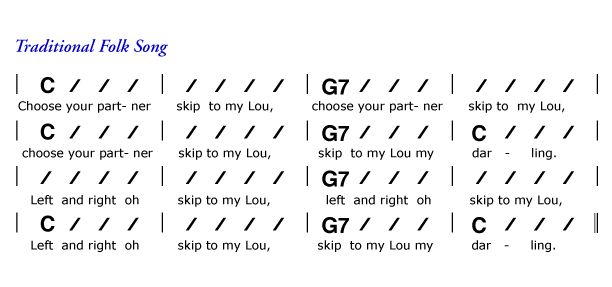
More Easy Beginner Guitar Songs
Once you have mastered the simple guitar chords, then it is time to learn how to play more easy guitar chords. Then go to our carefully selected group of 10 easy guitar songs for beginners!
Tips for Practicing Guitar
Have a clear idea of what you need to practice. Simply playing the same two songs over and over will not make you progress. In general, consider putting time aside for these three areas:
- Improve guitar technique and strengthen your fingers. Remember that everyone needs to warm-up before playing and performing. Ways to do that effectively are to practice playing scales in different positions on the neck, changing between chords in common chord progressions, picking and fingerpicking, and playing in-tempo with a metronome. Start SLOWLY. Try to play CLEANLY without extra noise from accidentally hitting open strings, or accidentally muting notes by not holding down a note on the fret properly. Getting good tone will help make you a great player.
- Practice songs and repertoire. Once you are all warmed-up, now is the time to practice the songs you know. Don’t rush them, but make sure that you are cleanly changing chords, hearing all the notes, and playing it at tempo without pausing.
- Learn something new. Stretch yourself with a new technique, song, or musical style. Learn music theory and train your ear.
Learn Faster with eMedia’s Interactive Beginner Guitar Lessons!
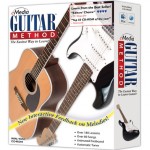 Guitar lesson software such as eMedia Guitar Method or eMedia Interactive Rock Guitar helps you learn how to play guitar faster. It provides a mix of great beginner guitar lessons by qualified teachers from leading music schools, and interactive music technology that gets you playing quickly. The Animated Fretboard and interactive guitar notation lets you see which notes to play, while the software listens to you and displays whether you’re actually playing the right note. Plus you learn hit songs like
Guitar lesson software such as eMedia Guitar Method or eMedia Interactive Rock Guitar helps you learn how to play guitar faster. It provides a mix of great beginner guitar lessons by qualified teachers from leading music schools, and interactive music technology that gets you playing quickly. The Animated Fretboard and interactive guitar notation lets you see which notes to play, while the software listens to you and displays whether you’re actually playing the right note. Plus you learn hit songs like Knockin’ on Heaven’s Door
and Rock’n Me.
Beware of Common Practicing Mistakes
Here are some really common mistakes made by new guitarists. As you practice and learn how to play guitar please keep them in mind. Be patient, as mastering any instrument takes a lot of practice.
- Remember to tune your guitar first and warm-up your hands.
- Be patient.
- Practice slowly and watch your hands to have good guitar technique.
- Practice with a metronome to have a steady feel for tempo and keeping the beat.
- Change your chords on the the beat. Better to play slowly in rhythm than fast and miss a chord.



